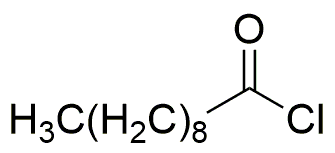Decanoyl chloride is widely utilized in research focused on:
- Synthesis of Esters: It serves as a key reagent in the production of esters, which are important in the flavor and fragrance industry. For example, it can be used to create fruity scents in perfumes.
- Pharmaceutical Intermediates: This compound is crucial in synthesizing various pharmaceutical agents, enhancing drug formulations, and improving bioavailability. Its ability to modify molecular structures makes it valuable in drug development.
- Polymer Production: Decanoyl chloride is used in the manufacture of polyamides and other polymers, which are essential in creating durable materials for textiles and automotive applications.
- Surface Coatings: It is employed in the formulation of surface coatings and adhesives, providing enhanced adhesion properties and chemical resistance, beneficial in construction and manufacturing sectors.
- Research Applications: In academic and industrial laboratories, it is used for chemical research and development, particularly in studying reaction mechanisms and developing new synthetic pathways.
Información general
Propiedades
Seguridad y normativas
Aplicaciones
Decanoyl chloride is widely utilized in research focused on:
- Synthesis of Esters: It serves as a key reagent in the production of esters, which are important in the flavor and fragrance industry. For example, it can be used to create fruity scents in perfumes.
- Pharmaceutical Intermediates: This compound is crucial in synthesizing various pharmaceutical agents, enhancing drug formulations, and improving bioavailability. Its ability to modify molecular structures makes it valuable in drug development.
- Polymer Production: Decanoyl chloride is used in the manufacture of polyamides and other polymers, which are essential in creating durable materials for textiles and automotive applications.
- Surface Coatings: It is employed in the formulation of surface coatings and adhesives, providing enhanced adhesion properties and chemical resistance, beneficial in construction and manufacturing sectors.
- Research Applications: In academic and industrial laboratories, it is used for chemical research and development, particularly in studying reaction mechanisms and developing new synthetic pathways.
Documentos
Hojas de datos de seguridad (HDS)
La SDS proporciona información de seguridad completa sobre la manipulación, el almacenamiento y la eliminación del producto.
Especificación del producto (PS)
La PS proporciona un desglose completo de las propiedades del producto, incluida la composición química, el estado físico, la pureza y los requisitos de almacenamiento. También detalla los rangos de calidad aceptables y las aplicaciones previstas del producto.
Certificados de análisis (COA)
Busque certificados de análisis (COA) ingresando el número de lote del producto. Los números de lote y de partida se pueden encontrar en la etiqueta de un producto después de las palabras "Lote" o "Lote".
Número de catálogo
Número de lote/lote
Certificados de origen (COO)
Este certificado de origen confirma el país en el que se fabricó el producto y también detalla los materiales y componentes utilizados en él y si se deriva de fuentes naturales, sintéticas u otras fuentes específicas. Este certificado puede ser necesario para cumplir con las normativas aduaneras, comerciales y regulatorias.
Número de catálogo
Número de lote/lote
Hojas de datos de seguridad (HDS)
La SDS proporciona información de seguridad completa sobre la manipulación, el almacenamiento y la eliminación del producto.
DownloadEspecificación del producto (PS)
La PS proporciona un desglose completo de las propiedades del producto, incluida la composición química, el estado físico, la pureza y los requisitos de almacenamiento. También detalla los rangos de calidad aceptables y las aplicaciones previstas del producto.
DownloadCertificados de análisis (COA)
Busque certificados de análisis (COA) ingresando el número de lote del producto. Los números de lote y de partida se pueden encontrar en la etiqueta de un producto después de las palabras "Lote" o "Lote".
Número de catálogo
Número de lote/lote
Certificados de origen (COO)
Este certificado de origen confirma el país en el que se fabricó el producto y también detalla los materiales y componentes utilizados en él y si se deriva de fuentes naturales, sintéticas u otras fuentes específicas. Este certificado puede ser necesario para cumplir con las normativas aduaneras, comerciales y regulatorias.


